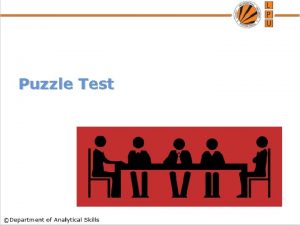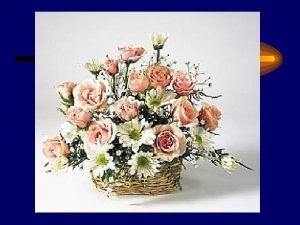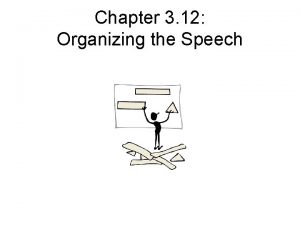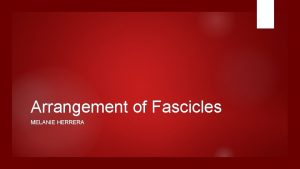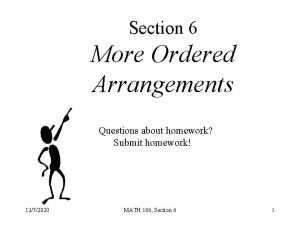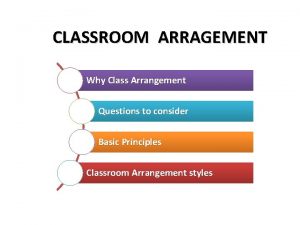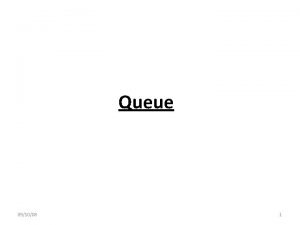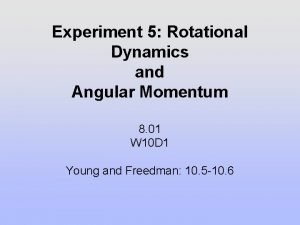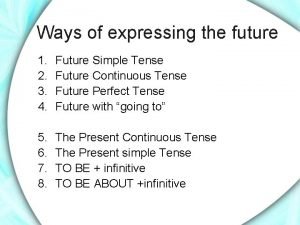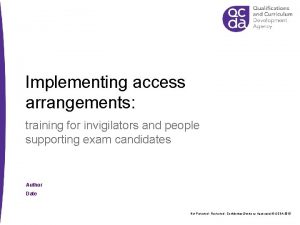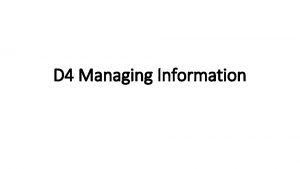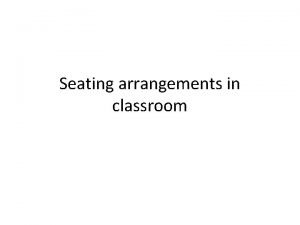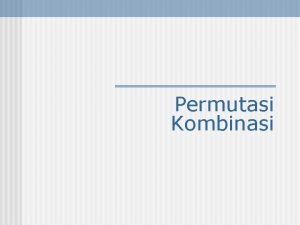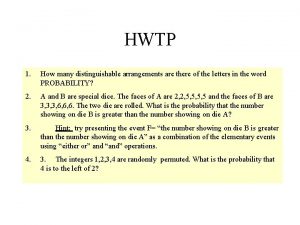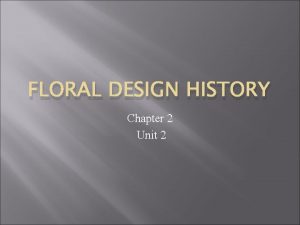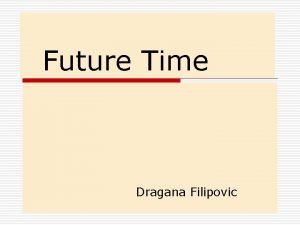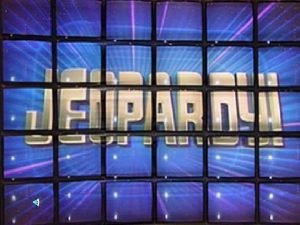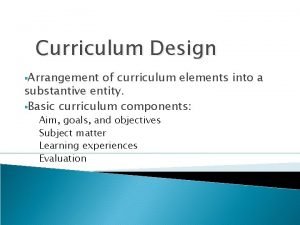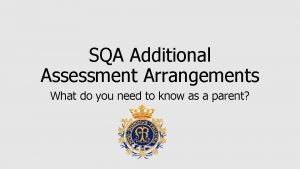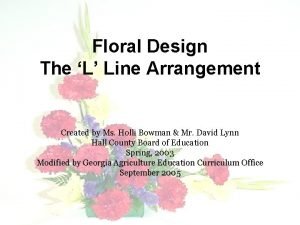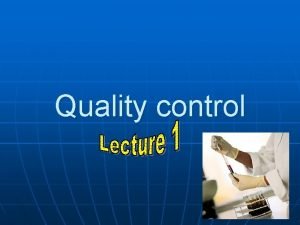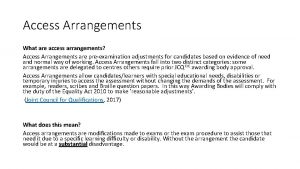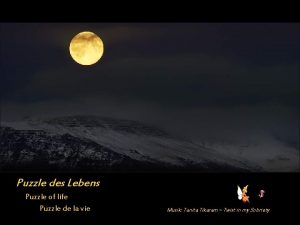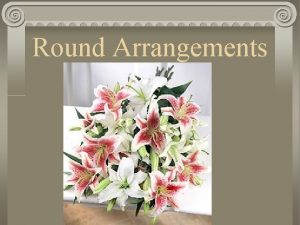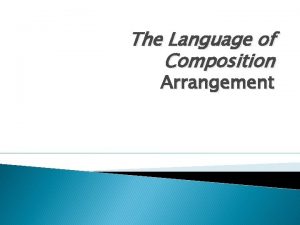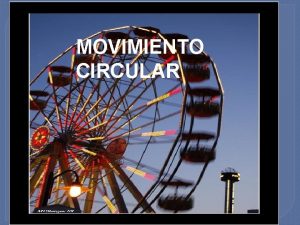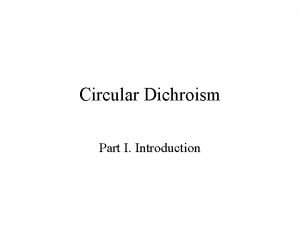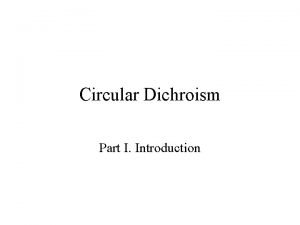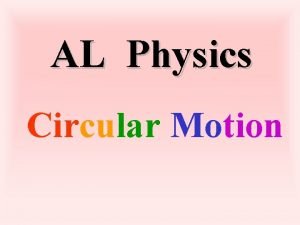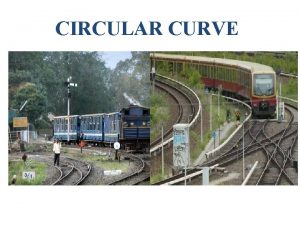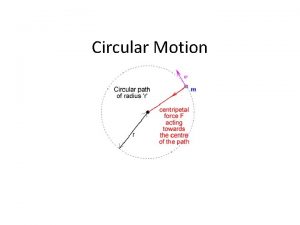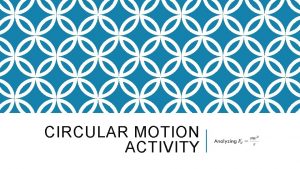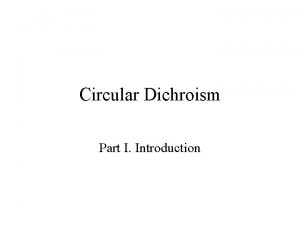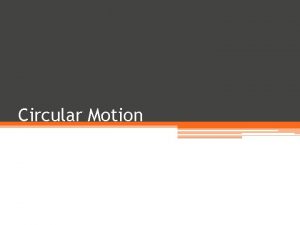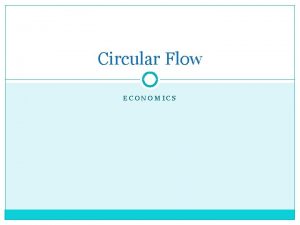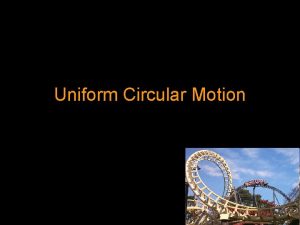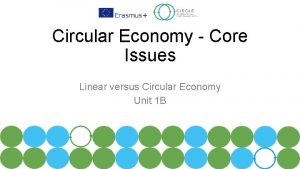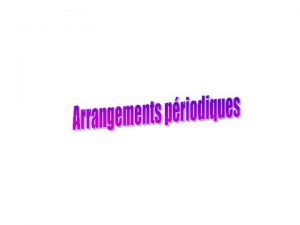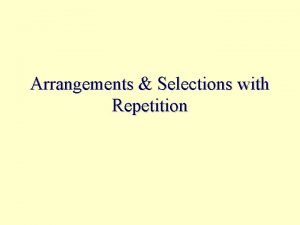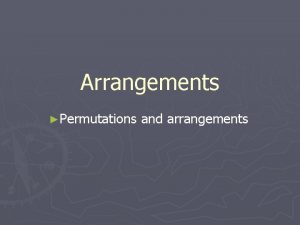Puzzle Test Content Arrangements Linear Arrangement Circular Arrangement








































- Slides: 40

Puzzle Test

Content Arrangements: Linear Arrangement Ø Circular Arrangement Ø Cross Variable Arrangement Ø Linear Relationship Ø Selection decision table

For Solving Arrangements: Check the direction in which the arrangement is specified. First go for Direct clues Followed by the indirect clues related to the direct clue. Then you can deal with the remaining clues. There can be more than one possible arrangements. Do not waste your time in guessing one. Instead read the question again. 99% cases your answer will be the same in both the possible arrangements. ‘Immediately’ or ‘next’ means – placed immediately (adjacent position) after the required variable. ‘After’ means – can be anywhere after the specified variable.

Example for linear Arrangement: Read the following information carefully and answer the questions given below: Ø Six lectures A, B, C, D, E and F are to be organized in a span of seven days - from Sunday to Saturday - with only one lecture on each day in accordance with the following : A should not be organized on Thursday. (ii) C should be organized immediately after F. (iii) There should be a gap of two days between E and D. (iv) One day there will be no lecture (Friday is not that day). Just before that day, D will be organized. (v) B should be organized on Tuesday and should not be followed by D. (i)

Using the initial clues the following arrangements are possible: S M T W T F S A E B F C D X B E F C A X A B E F C D But according to the last clue B should not be followed D. Hence only possible arrangement is S M T W T F S D X B E F C A

1. a) b) c) d) On which day is there no lecture? Monday Sunday Friday Cannot be determined Ans: a) Monday 2. a) b) c) d) How many lectures are organized between C and D? None One Two Three Ans: d) Three

3. a) b) c) d) On which day will the lecture F be organized Thursday Friday Saturday Sunday Ans: a) Thursday 4. a) b) c) d) Which of the following is the last lecture in the series? A B C Cannot be determined Ans: a) A

Read the paragraph carefully and answer the questions below it. Ø Nine family members are sitting in a theatre in one row. They are J, K, L, M, N, O, P, Q and R. L is at the immediate right of M and at third place at the right of N. K is at one end of the row. Q is immediately next to O and P. O is at the third place at the left of K. J is right next to the left of O.

The arrangement will be N R M L J O Q P K 1. Which of the following statement is true? a) There is one person between L and O R and P are neighbors M is at one extreme end N is at two seats away from J None of the above b) c) d) e) Ans: a) There is one person between L and O

2. The family members sitting on the right of O are a) RML JQP QPK KPR Cannot be determined b) c) d) e) Ans: c) QPK 3. Who is sitting in the centre of the row? a) L J O Q None of the above b) c) d) e) Ans: b) J

4. a) b) c) d) e) Who are sitting next to L? A and O M and J M and O P and J Data Inadequate Ans: b) M and J 5. a) b) c) d) e) Who is at the other end of the row? R J P N Q Ans: d) N

Read the following information carefully and answer the questions given below: I. Eight rooms P, Q, R, S, T, U, V and W are located adjacent to one another in two different rows with four in each row. II. Doors of the rooms of one row open into the doors of the rooms of another row. III. No room of consecutive letter is either adjacent or opposite to each other. IV. rows. P and Q are the rooms located at the end of two different V. R is just left of T and is located in the same row in which P is located. VI. U is just left of Q.

The only possible arrangement is Q U W S V R T P Doors of the rooms of one row open into the doors of the rooms of another row. No room of consecutive letter is either adjacent or opposite to each other. P and Q are the rooms located at the end of two different rows. R is just left of T and is located in the same row in which P is located. U is just left of Q.

1. Which room is opposite to P? a) S U W Cannot be determined b) c) d) Ans: a) S 2. Which room is diagonally opposite to S? a) Q W V Cannot be determined b) c) d) Ans: c) V

3. Which room is opposite to R? a) U W Q Cannot be determined b) c) d) Ans: a) U 4. Which room/(s) is /are adjacent to W? a) R U and S Q and U Cannot be determined b) c) d) Ans: b) U and S

5. Which of the following room is not located at either ends? a) Q V S W b) c) d) Ans: d) W

Example for circular arrangement: Study the following information to answer the questions given below: I. Eight persons E, F, G, H, I, J, K and L are seated around a square tabletwo on each side. II. There are three lady members and they are not seated next to each other. III. J is between L and F. IV. G is between I and F. V. H, a lady member is second to the left of J. VI. F, a male member, is seated opposite to E, a lady member. VII. There is a lady member between F and I.

1. Who among the following are three lady members? a) E, H and J E, G and J G, H and J None of these b) c) d) Ans: d)None of these 2. Which of the following is true about J? a) J is a male member. J is a female member. Sex of J cannot be determined. Position of J cannot be determined. b) c) d) Ans: a) J is a male member.

3. Who among the following is seated between E and H? a) I J F None of these b) c) d) Ans: d) None of these 4. Who among the following is to the immediate left of F? a) G J I Cannot be determined b) c) d) Ans: b) J

5. How many persons are seated between K and F? a) One Two Three Cannot be determined b) c) d) Ans: c) Three

Read the following information and answer the questions based on it. A, B, C, D, E, F and G are playing cards sitting in a circle. F is second to the right of G. (ii) B is neighbours of F but not of E (iii) E the neighbor of C, is 4 th to the right of G. (iv) D is between E and A. (i)

E C D F A B G

Who is fourth to the left of G? a) D b) E c) C d) Cannot be Determined Ans: c) C 1. Who is to the left of G? a) A b) B c) C d) Cannot be determined Ans: a) A 3. Who are the neighbours of F? a) E and C b) F and B c) A and B d) C and B Ans: d) C and B 2.

1. There are six dishes P through U, among which two are starters, two are main course dishes and two are desserts. They are arranged in a circular order. P is adjacent to U R is not adjacent to either Q or T S is a main course and is adjacent to the desserts. Both the starters are adjacent to each other. P is opposite a dessert which is not Q. Which dish is opposite to T? P Q R S

2. Which of the following is definitely a correct combination? a) Q - Dessert b) U – Main Course c) U- starter d) Q – starter

3. Which of the following is true? One of the desserts is opposite to a main course B. One main course is opposite to a starter C. P is a starter D. More than one of the above A.

4. Which dishes are adjacent to Q? P and R B. T and U C. S and U D. T and P A.

5. Which of the following dishes cannot be together? P and T B. S and T C. U and Q D. P and R A.

Q. Seven people P, Q, R, S, T, W and X are sitting in a straight line facing North, not necessarily in the same order. R sits at one of the extreme ends of the line. T has as many people sitting on his right, as on his left. S sits third to the left of X. Q sits on the immediate left of W. Q does not sit at any of the extreme ends of the line. 1) If all the people are made to sit in alphabetical order from right to left, the positions of how many people will remain unchanged? A) Five B) One C) Three D) Two E) None of these

2) How many people sit to the right of P? A) Four B) Five C) Two D) One E) None of these

Directions: A precious diamond stone is stolen from the famous London Museum. The thieves were suspected to be hiding in any one of the following five cities- Nottingham, Brisbane, Harare, Senegal and Port Blair. One chief officer from each of these five places namely Adam, Nathan, Farzana, Tom Anderson and Benazir have been called for a meeting and each of them is assigned to arrest the suspects. None of them was posted in own home town and each of them likes five different dishes - Chicken tikka, Prawn butter fry, Pork Sanwich, Hot dog and crab lollypop.

Tom who lives in Port Blair likes Hotdog and Adam who is posted in Senegal likes prawn butter fry. One who is posted in Brisbane likes Crab lollypop. Farzana’s hometown is Brisbane and she is posted in Nottingham. Adam, Nathan and Tom are posted in home towns of Nathan, Tom and Adam respectively. Officers Tom Adam Natham Farzana Benazir Hometown Posting Food

Officers Hometown Posting Food Tom Portblair Harare Hotdog Adam Harare Senegal Prawn Natham Senegal Portblair Chick or pork Farzana Brisbane Nottingham Chick or pork Benazir Nottingham Brisbane Crab

1. Who is posted in Brisbane? (a) Adam (b)Nathan (c)Farzana (d)Benazir (e) Tom anderson Ans: d) Benazir 2. Which of the following is Tom’s posting place? (a) Brisbane (b) Senegal (c) Harare (d)Port Blair (e) Nottingham Ans: c) Harare 3. Which of the following is correct? (a)Tom- PB, Adam-Bris, Nathan-Senegal, Farzana- Harare (b)Tom-PB, Adam-Harare, Farzana-Brisbane, Nathan- Senegal (c)Tom-PB, Adam-Harare, Farzana- Notting, Nathan- Senegal (d)None of these. Ans: b

4. What is Benezir’s home town? (a)Nottingham (b)Harare (c)Port Blair (d)Brisbane (e)Senegal Ans: a) Nottingham 5. Which of the following could be Farzana’s favourite dish? (a) Port Sandwich (b) Hotdog (c)Chicken tikka (d) a or b (e) a or c Ans: e) a or c

Example for Cross Variable Arrangement: Ø There are seven friends – B, S, R, M, G, Y and K, each of them aspires to become something and likes different colors viz. Blue, Yellow, Green, Violet, Maroon, Black and Red not necessarily in the same order and Each of them wants to become Lawyer, Doctor, Engineer, Actor, Pilot, Army Chief and Cricketer not necessarily in the same order. Ø G likes Violet color and wants to become Doctor. R like Yellow color and wants to become a Cricketer. Ø Ø K does not like Black color and does not want to become an Engineer. The person who likes Maroon color, wants to become an Actor while the person who wants to be Pilot likes blue color. Ø B likes red color but Y does not like green or black color and he does not want to become an Actor. Ø M wants to become a Lawyer. S does not want to become an Engineer or an Army Chief.

Blue Yellow Green Violet Maroon Lawyer G Eng B Actor S Y Army Cricket Red M Doctor Pilot Black K R v G likes Violet colour and wants to become Doctor. R like Yellow colour and wants to become a Cricketer. v K does not like Black colour and does not want to become an Engineer. v The person who likes Maroon colour, wants to become an Actor while the person who wants to be Pilot likes blue colour. v B likes red colour but Y does not like green or black colour and he does not want to become an Actor. v M wants to become a Lawyer. S does not want to become an Engineer or an Army Chief.

1. (a) (b) (c) (d) (e) Who does want to become an Army Chief? Y K B Data Inadequate None 2. The person who wants to become a Lawyer likes which colour? (a) Red (b) Green (c) Blue (d) Data Inadequate (e) None 3. Y want to become a/an: (a) Army chief (b) Actor (c) Engineer (d) Pilot (e) None

4. Who does like Maroon color? (a) S (b) Y (c) K (d) Data Inadequate 5. Which of the following combinations of person – color – profession is correct? (a) M – Blue – Lawyer (b) B –Red – Cricketer (c) Y – Blue – Pilot (d) S – Green – Actor

 Linear and circular arrangement
Linear and circular arrangement Carrier content vs real content
Carrier content vs real content Static content vs dynamic content
Static content vs dynamic content What are the 5 elements of hair design
What are the 5 elements of hair design Circular mass floral design
Circular mass floral design Circular organizational arrangement
Circular organizational arrangement Multipennate
Multipennate Circular arrangement questions
Circular arrangement questions Classroom seating arrangements advantages and disadvantages
Classroom seating arrangements advantages and disadvantages Linear queue
Linear queue Angular momentum of disc
Angular momentum of disc Expressing future plans and arrangements
Expressing future plans and arrangements Assortment warehouse
Assortment warehouse Renaissance period floral design
Renaissance period floral design Access arrangements training
Access arrangements training Roman period floral arrangements
Roman period floral arrangements Serie of events arranged in a story.
Serie of events arranged in a story. Procedures relating to the management of information
Procedures relating to the management of information Horizontal row seating formation
Horizontal row seating formation Arrangements and permutations
Arrangements and permutations Reactive effects of experimental arrangements
Reactive effects of experimental arrangements Hwtp
Hwtp Egyptian time period floral design
Egyptian time period floral design Con 100 shaping smart business arrangements
Con 100 shaping smart business arrangements French floral design history
French floral design history Objectives of foreign collaboration
Objectives of foreign collaboration Present continuous plans
Present continuous plans Dragana filipovic
Dragana filipovic Shannon is making identical balloon arrangements
Shannon is making identical balloon arrangements Arrangement of the elements of the curriculum
Arrangement of the elements of the curriculum Assessment arrangements
Assessment arrangements Sahar mahdi
Sahar mahdi Line arrangements
Line arrangements Egyptian flower arrangements
Egyptian flower arrangements Starting a busness
Starting a busness Assessment and reporting arrangements 2017
Assessment and reporting arrangements 2017 Content uniformity usp
Content uniformity usp Large-volume parenterals
Large-volume parenterals Usp weight variation limits
Usp weight variation limits Delivered dose uniformity
Delivered dose uniformity Simple linear regression and multiple regression
Simple linear regression and multiple regression
